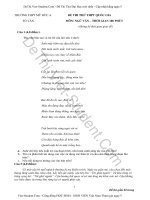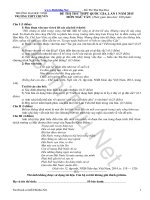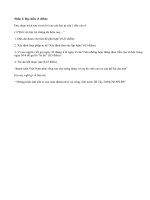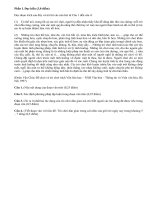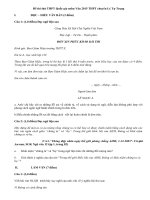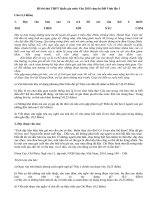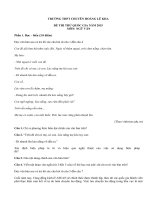ĐỀ THI THỬ THPT QUỐC GIA ANH VĂN 2018 (19)
Bạn đang xem bản rút gọn của tài liệu. Xem và tải ngay bản đầy đủ của tài liệu tại đây (656.86 KB, 8 trang )
ĐỀ THI THỬ THPT QUỐC GIA 2017
Thời gian làm bài: 60 phút
Mark the letter A, B, C, or D on your answer sheet to indicate the words whose pronunciation is different from the
others in each of the following questions.
Question 1: A. required
B. blamed
C. dissolved
D. talked
Question 2: A. attract
B. argument
C. apply
D. vacancy
Mark the letter A, B, C, or D on your answer sheet to indicate the word that differs from the other three in the
position of the primary stress in each of the following questions.
Question 3: A. approximate
B. congratulate
C. psychological
D. biography
Question 4: A. rhinoceros
B. advertisement
C. eventually
D. dedicated
Mark the letter A, B, C, or D on your answer sheet to indicate the underlined part that needs correction in each of
the following questions
Question 5: An increasing number of companies has changed dress codes, allowing employees to wear casual clothing in
the work place.
A. increasing
B. has changed
C. to wear
D. in the work place
Question 6: Among the earliest telescopes were Galilean telescopes, modeled after the simple instruments built by Galileo,
the first person having used telescopes to study the stars and planets.
A. telescopes
B. were
C. modeled
D. having used
Question 7: Mr. Lam insisted that we show our best knowledge, our enthusiasm, our keen on work and our sense of
responsibility when working in a team.
A. show
B. keen on
C. sense of
D. when working
Mark the letter A, B, C, or D on your answer sheet to indicate the correct answer to each of the following questions
Question 8: In England, English, Math and Science are _________ subjects at school.
A. more
B. store
C. score
D. core
Question 9: It’s _____ to transfer drugs in our country.
A. legally
B. illegally
C. illegal
D. legal
Question 10: The guidelines in this book can help you become a _________ speaker.
A. confide
B. confident
C. confidence
D. self-confidence
Question 11: If people drove more carefully, there _________ so many accidents on the road.
A. would not be
B. will not be
C. wouldn’t have been
D. aren’t
Question 12: ________ he got top marks at high school, he never went to university.
A. Despite
B. Although
C. Meanwhile
D. Nevertheless
Question 13: When Jack _________ me, I _____________ a letter.
A. phoned - has been writing
B. has phoned - was writing C. phoned - was writing
D. was phoning - wrote
Question 14: ____________ migrate long distances is well documented.
A. That birds
B. Birds
C. A bird
D. The birds
Question 15: - Joe: “This file is very important. You should include it in our document.”
- Paul: “I know. It is ______.”
A. significant
B. optional
C. indistinct
D. indispensable
Question 16: This carpet really needs_______. Can you do it for me, son?
A. being cleaned
B. clean
C. cleaned
D. cleaning
Question 17: I realized _______ that he was a thief.
A. eventually
B. sooner or later
C. at the beginning
D. all along
Question 18: Designers are experimenting with a new material ________ flexibly with lightness.
A. combines
B. combination of
C. combining
D. is combining
Question 19: When she died, she gave ________ all her money to a charity for cats.
A. on
B. off
C. out
D. away
Mark the letter A, B, C, or D on your answer sheet to indicate the most suitable response to complete each of the
following exchanges
Question 20: “That’s a beautiful dress you are wearing!” - “___________________”
A. Can I have it?
B. It’s in the wash
C. I’m glad you like it
D. Oh, no, not really
Question 21: “Would you like some chocolate?” - “__________________”
A. I love it
B. Yes, please!
C. Here you go
D. Here you are
Mark the letter A, B, C, or D on your answer sheet to indicate the word(s) CLOSEST in meaning to the underlined
word(s) in each of the following questions
Question 22: The fourth-year sociology class was a homogeneous group of university students.
A. unrelated
B. uniform
C. distinguishable
D. dreary
Question 23: I only have time to tell you the main idea of it, not the details.
A. fist
B. gist
C. twist
D. list
Mark the letter A, B, C, or D on your answer sheet to indicate the word(s) OPPOSITE in meaning to the underlined
word(s) in each of the following questions
Question 24: My mother is a caring woman and always thoughtful of others.
A. rude
B. inconsiderate
C. inconsiderable
D. critical
Question 25: There is no excuse for your discourtesy. Think twice before you are going to say anything.
A. bravery
B. impoliteness
C. politeness
D. boldness
Mark the letter A, B, C, or D on your answer sheet to indicate the sentence that is closest in meaning to each of the
following questions
Question 26: If there hadn’t been such a strong wind, it would not have been so difficult to put out the fire.
A. It was the strong wind which made it difficult for us to put out the fire.
B. When a strong wind began to blow, it was even more difficult to control the fire.
C. If the wind hadn’t been so strong, it would have been much easier to put out the fire.
D. As the wind was really very strong, it took them a long time to put out the fire.
Question 27: You should have finished the report by now, Jason told his secretary.
A. Jason reproached his secretary for not having finished the report.
B. Jason said that his secretary had not finished the report.
C. Jason reminded his secretary of finishing the report on time.
D. Jason scolded his secretary for not having finished the report.
Question 28: No sooner had Mary begun her new job than she knew she had made a mistake.
A. As soon as Mary started working, she realized that her decision had not been a good one.
B. Had Mary not just begun a new job, she would have gone looking for a better one.
C. Just before Mary took up her new post, she realized that she was not suited for it.
D. Since Mary did not like her new job, she began looking for one more suitable to her.
Mark the letter on your answer sheet to indicate the sentence that best combines each pair of sentences
Question 29: Despite his seeming control over nature, there are still some points where man remains helpless against
her.
A. Man is defenseless against nature, because he cannot have any influence on her.
B. Although man has an apparent control over nature, he hasn't fully conquered her yet.
C. Man believes he has complete control over nature, but in many respects, this isn 't so.
D. Even though man can affect her, in many areas nature still does things better.
Question 30: The teacher gave some instructions. I don’t understand any of them.
A. The instructions the teacher gave are not understanding to me.
B. It was the instructions the teacher gave that confused me.
C. It hasn’t been clear to me about the instructions given.
D. I’m finding it difficult to figure out what the teacher required according to his instructions.
Read the following passage and mark the letter A, B, C, or D on your answer sheet to indicate the correct word or
phrase that best fits each of the numbered blanks from 31 to 35
Our Homes: Now and Then
Everyone needs a home where they feel sheltered and safe. Today we live in modern flats and houses,
(31) _______ have air-conditioning to keep us cool, and heating to keep us warm. There is electricity
for lighting and supplies of gas or oil for the heating. Hot and cold water (32) ________ from the taps
and dirty water disappears (33) _______ the drains. Many of our homes have balconies or
gardens.
In the past, people made their homes from materials that they found nearby. When we look at different
houses we can tell how old they are from the materials used and the way they were built.
It was different long (34) _______ people did not have water in their homes and there were no
electric lights. To keep warm, they sometimes made (35) _______ inside their homes. With a fire
started they could cook their food and heat water.
Question 31: A. who
B. which
C. where
D. whose
Question 32: A. flows
B. finds
C. flies
D. floats
Question 33: A. up
B. towards
C. on
D. down
Question 34: A. back
B. then
C. ago
D. time
Question 35: A. flames
B. food
C. fires
D. furnaces
Read the following passage and mark the letter A, B, C, or D on your answer sheet to indicate the correct answer to
each of the questions from 36 to 43
First man on the moon
On July 16, 1969, America launched the Apollo 11, Lunar Landing Mission from Kennedy Space Center. This was a 363foot-tall space vehicle, the five engines of which on the Saturn V rocket generated 7.5 million pounds of thrust. Twelve
minutes after the launch, the astronauts were in orbit 120 miles above the Earth. [1] At a speed of 17,400 mph, they began
their four-day journey to the moon. [2] They had nearly a quarter of a million miles to go.
On July 20, 1969, Neil Armstrong descended from the lunar module ladder. [3] Just prior to taking his first step on the
moon, Armstrong pilled on a special ring, causing a TV camera to automatically deploy. As he stepped onto the moon’s
surface he proclaimed, “That’s one small step for man, one giant leap for mankind”. [4] However, Armstrong inadvertently
omitted the “a” before “man”. This error slightly changed the meaning of what was to become known as Armstrong’s famous
statement.
Question 36: What is this passage mainly about?
A. the first manned mission to the moon
B. how fast the rocket traveled
C. the first man in space
D. the reason Neil Armstrong is so famous
Question 37: The word “They” in the passage refers to________.
A. Apollo 11
B. astronauts
C. Americans
D. engines
Question 38: The word “deploy” in the passage is closet in meaning to _____.
A. photograph
B. Begin working
C. Stop functioning D. Light up
Question 39: Which of the following is the best title for this passage?
A. The Life Of Neil Armstrong
B. The History Of Space Travel
C. The Story Of Apollo 11
D. The Reason Neil Armstrong Is So Famous
Question 40: It can be inferred that Armstrong’s statement was important because _____________.
A. Neil Armstrong was a great speaker
B. they were the first words to be spoken on the moon
C. this was the first time America had sent people to space
D. the statement was spoken from the lunar module ladder
Question 41: Which is the best place for the following sentence?
“He was about to make history”
A. [1]
B. [2]
C. [3]
D. [4]
Question 42: The paragraph following the text would most likely discuss __________.
A. the events that happened on July 21, 1969
B. the completely successful mission of Apollo 12
C. the pictures that the astronauts took on the Moon
D. How the omission of “a” changed the meaning of the statement
Question 43: Complete the summary below by choosing one sentence that expresses one of the most important ideas in the
passage.
Summary: This passage discusses the Apollo 11 space mission. Apollo 11 was an American spacecraft that took the first
astronauts to the moon. Armstrong was the first man to step on the moon. ________________________
A. Apollo 11 was a large vehicle launched by a Saturn V rocket
B. The journey to the moon took four days
C. Armstrong made a meaningful mistake in his speech as he took his first steps
D. A special ring caused a TV camera to begin operating.
Read the following passage and mark the letter A, B, C, or D on your answer sheet to indicate the correct answer to
each of the questions from 44 to 50
In the West, cartoons are used chiefly to make people laugh. The important feature of all these cartoons is the joke and the
element of surprise which is contained. Even though it is very funny, a good cartoon is always based on close observation of
a particular feature of life and usually has a serious purpose.
Cartoons in the West have been associated with political and social matters for many years. In wartime, for example, they
proved to be an excellent way of spreading propaganda. Nowadays cartoons are often used to make short, sharp comments
on politics and governments as well as on a variety of social matters. In this way, the modern cartoon has become a very
powerful force in influencing people in Europe and the United States.
Unlike most American and European cartoons, however, many Chinese cartoon drawings in the past have also attempted
to educate people, especially those who could not read and write. Such cartoons about the lives and sayings of great men in
China have proved extremely useful in bringing education to illiterate and semi-literate people throughout China. Confucius,
Mencius and Laozi have all appeared in very interesting stories presented in the form of cartoons. The cartoons themselves
have thus served to illustrate the teachings of the Chinese sages in a very attractive way.
In this sense, many Chinese cartoons are different from Western cartoons in so far as they do not depend chiefly on telling
jokes. Often, there is nothing to laugh at when you see Chinese cartoons. This is not their primary aim. In addition to
commenting on serious political and social matters, Chinese cartoons have aimed at spreading the traditional Chinese
thoughts and culture as widely as possible among the people.
Today, however, Chinese cartoons have an added part to play in spreading knowledge. They offer a very attractive and
useful way of reaching people throughout the world, regardless of the particular country in which they live. Thus, through
cartoons, the thoughts and teachings of the old Chinese philosophers and sages can now reach people who live in such
countries as Britain, France, America, Japan, Malaysia or Australia and who are unfamiliar with the Chinese culture.
Until recently, the transfer of knowledge and culture has been overwhelmingly from the West to the East and not vice
versa. By means of cartoons, however, publishing companies in Taiwan, Hong Kong and Singapore are now having success
in correcting this imbalance between the East and the West.
Cartoons can overcome language barriers in all foreign countries. The vast increase in the popularity of these cartoons
serves to illustrate the truth of Confucius’s famous saying “One picture is worth a thousand words.”
Question 44: Which of the following clearly characterizes Western cartoons?
A. Enjoyment, liveliness, and carefulness
B. Seriousness, propaganda, and attractiveness
C. Humor, unexpectedness, and criticism
D. Originality, freshness, and astonishment
Question 45: Chinese cartoons have been useful as an important means of ____________.
A. educating ordinary people
B. spreading Western ideas
C. amusing people all the time
D. political propaganda in wartime
Question 46: The passage is intended to present _______________.
A. a contrast between Western cartoons and Chinese cartoons
B. a description of cartoons of all kinds the world over
C. an outline of Western cartoons and Chinese cartoons
D. an opinion about how cartoons entertain people
Question 47: In general, Chinese cartoons are now aiming at ______________.
A. bringing education to illiterate and semi-literate people in the world
B. disseminating traditional practices in China and throughout the world
C. illustrating the truth of Chinese great men’s famous sayings
D. spreading the Chinese ideas and cultural values throughout the world
Question 48: Which of the following is most likely the traditional subject of Chinese cartoons?
A. Jokes and other kinds of humor in political and social matters.
B. The philosophies and sayings of ancient Chinese thinkers.
C. The illiterate and semi-literate people throughout China.
D. The stories and features of the lives of great men the world over.
Question 49: According to the passage, which of the following is true?
A. Western cartoons always have a serious purpose.
B. Language barriers restricted cartoons.
C. Cartoons will replace other forms of writing.
D. Cartoons can serve various purposes.
Question 50: Which of the following could be the best title for the passage?
A. Chinese Cartoons and Western Cartoons
B. A Very Powerful Force in Influencing People
C. An Excellent Way of Spreading Propaganda
D. Cartoons as a Way of Educating People
ĐÁP ÁN ĐỀ THI THỬ TIẾNG ANH SỐ 2
Câu
1
2
3
4
5
6
7
8
9
10
Đáp án
D
B
C
D
B
D
B
D
C
B
Câu
11
12
13
14
15
16
17
18
19
20
Đáp án
A
B
C
A
D
D
D
C
D
C
Câu
21
22
23
24
25
26
27
28
29
30
Đáp án
B
B
B
B
C
A
A
A
B
C
Câu
31
32
33
34
35
36
37
38
39
40
Đáp án
B
A
D
C
C
A
B
B
C
C
Câu
41
42
43
44
45
46
47
48
49
50
Đáp án
C
D
C
C
A
A
D
B
D
A
Question 1: Đáp án D.
Theo quy tắc đọc đuôi -ed, từ “talk” kết thúc bằng /k/, đuôi -ed đọc là /t/, các từ còn lại đọc là /d/
Question 2: Đáp án B.
Từ “argument” có phần gạch chân được phát âm là /a:/, các từ cịn lại có phần gạch chân được phát âm là /ə/
Question 3: Đáp án là C.
Từ “psychological” có trọng âm rơi vào âm tiết thứ ba, các từ cịn lại có trọng âm rơi vào âm tiết thứ hai.
Question 4: Đáp án là D.
Từ “dedicated” nhấn âm thứ nhất, các từ còn lại nhấn thứ hai.
Question 5: Đáp án là B.
Sửa: has changed => have changed. Vì: A (hoặc An) number + danh từ đếm được số nhiều: nhiều .... , theo sau
động từ chia ở dạng số nhiều
Question 6: Đáp án là D.
Sửa: having used => to have used. Vì sau “the first...”, dùng to V.
Question 7: Đáp án là B.
Sửa: keen on => keenness on, vì sau tính từ sở hữu “our” là danh từ.
Question 8: Đáp án là D.
Core subjects: mơn học chính
Question 9: Đáp án là C.
Illegal (adj): bất hợp pháp. Chỗ cần điền là một tính từ vì đứng đằng sau động từ to be “is”
Question 10: Đáp án là B.
Confident (adj): tự tin. Từ cần điền là một tính từ vì sau mạo từ “a” trước danh từ “speaker”
Question 11: Đáp án là A.
Đây là câu điều kiện loại 2: If + S + V-ed, S + would + V.
Question 12: Đáp án là B.
Although + clause: mặc dù (chỉ sự tương phản)
Cách dùng các từ còn lại: Despite + N: mặc dù; Meanwhile + clause: trong lúc đó…; Nevertheless: tuy nhiên (thường
đứng đầu câu trước dấu phẩy).
Question 13: Đáp án là C.
Quá khứ tiếp diễn + when + Qúa khứ đơn giản. “When” là liên từ nối hai hành động, một hành động đang xảy ra
(chia ở thì q khứ tiếp diễn) thì có một hành động khác xen vào (chia ở quá khứ đơn giản)
Nghĩa câu: Khi Jack gọi điện cho tơi, thì tơi đang viết thư.
Question 14: Đáp án là A.
“That + mệnh đề” có thể đóng vai trị như một chủ ngữ, sau nó động từ chia ở dạng số ít.
Question 15: Đáp án là D.
Indispensable: rất cần thiết.
Nghĩa các từ còn lại: significant: đầy ý nghĩa; optional: không bắt buộc; indistinct: không rõ ràng
Question 16: Đáp án là D.
Chủ ngữ (chỉ vật) + need + V-ing: … cần được làm gì (mang nghĩa bị động)
Question 17: Đáp án đúng là D.
Liên từ “all along” = all the time = from the beginning: suốt thời gian qua, từ đầu.
Question 18: Đáp án đúng là C.
Đây là câu mệnh đề quan hệ rút gọn chủ ngữ trong câu chủ động, ta dùng V-ing.
Viết đầy đủ: “... with a new material which combines flexibly with lightness.”
Question 19: Đáp án đúng là D.
Give away st to sb: cho đi cái gì cho ai
Give off: Toả ra, phát ra, bốc ra, bốc lên, xơng lên (mùi, hơi nóng, khói... ).
Give out: Chia, phân phối, công bố
Question 20: Đáp án là C.
Dựa vào nghĩa:
That’s a beautiful dress you are wearing! - Cái váy bạn mặc rất đẹp! - Chỉ lời khen
I’m glad you like it! - Tơi vui lắm khi bạn thích nó.
Question 21: Đáp án là B.
Dựa vào nghĩa:
Would you like some chocolate? - Bạn có muốn ăn socola khơng? - Đây là lời mời
Yes, please! - Vâng, làm ơn! - Chỉ sự đồng tình với lời mời
Question 22: Đáp án là B.
Homogeneous = uniform: đồng nhất
Question 23: Đáp án là B.
Main idea = gist: ý chính
Question 24: Đáp án là B.
Thoughtful: sâu sắc >< inconsiderate: thiếu sâu sắc
Question 25: Đáp án là C.
Discourtesy: sự bất lịch sự >< politeness: sự lịch sự
Question 26: Đáp án là A.
Dựa theo nghĩa:
Câu gốc: Nếu khơng có cơn gió to, việc dập lửa đã khơng khó khăn đến thế
Đáp án A: Chính vì cơn gió to mà việc dập lửa khó khăn.
Question 27: Đáp án là A.
Dựa theo nghĩa:
Câu gốc: “Đáng lẽ giờ này cô phải xong bản báo cáo rồi chứ” John nói với cô thư ký
Đáp án A: John trách mắng cô thư ký vì chưa xong bản báo cáo
Question 28: Đáp án là A.
Dựa theo nghĩa:
Câu gốc: Vừa bắt đầu công việc mới thì Mary nhận ra cơ ấy đã phạm sai lầm
Đáp án A: Ngay khi vừa bắt đầu công việc mới thì Mary nhận ra quyết định của cơ ấy không phải đúng đắn.
Question 29: Đáp án là B.
Dựa vào nghĩa để chọn đáp án:
Câu đã cho: Mặc dù dường như đã kiểm sốt với thiên nhiên, vẫn cịn một số điểm mà con người vẫn bất lực
chống lại cô ấy.
Đáp án B: Mặc dù con người có một sự điều khiển rõ ràng đối với thiên nhiên, nhưng đã khơng chinh phục hồn
tồn cơ ấy.
Question 30: Đáp án là C.
Dựa vào nghĩa để chọn đáp án:
Câu đã cho: Giáo viên đưa ra một số hướng dẫn. Tôi không hiểu bất kỳ lời chỉ dẫn nào.
Đáp án C: Những chỉ dẫn được đưa không rõ lắm đối với tôi.
Question 31: Đáp án là B.
Đại từ quan hệ thay thế cho danh từ chỉ vật “flats and houses”, đóng vai trị làm chủ ngữ trước động từ “have” => Chỉ
chọn được đáp án “which”.
Question 32: Đáp án là A.
flow from: bắt nguồn từ ...
Question 33: Đáp án là D.
down: xuống. Nghĩa cả câu: water disappears down the drains. (nước biến mất xuống cống.)
Question 34: Đáp án là C.
long ago = a long time ago: thời gian dài trước đó.
Question 35: Đáp án là C.
make fire: nhóm lửa
Nghĩa các từ còn lại: flame: ngọn lửa; food: thức ăn; furnace: lò sưởi
Question 36: Đáp án là A.
Dựa vào tiêu đề bài viết “người đầu tiên trên mặt trăng”
Question 37: Đáp án là B.
“They“ thay thế cho “astronauts“: các phi hành gia
Question 38: Đáp án là B.
Deply = begin working: triển khai, bắt đầu công việc
Question 39: Đáp án là C.
“Câu chuyện về con tàu vũ trụ mang tên Apollo 11” => dựa vào những câu đầu của bài mô tả về con tàu và chuyến đi
Question 40: Đáp án là C.
Câu nói của Armstrong quan trọng vì đó là những từ ngữ đầu tiên được nói trên mặt trăng.
Question 41: Đáp án là C.
Vào ngày 20 tháng 6 năm 1969, Neil Armstrong bước xuống từ chiếc thang màu bạc. Anh ta chuẩn bị làm nên lịch
sử.
Question 42: Đáp án là D.
Dựa ý cuối trong bài: “However, Armstrong inadvertently omitted the “a” before “man”. This error slightly changed the
meaning of what was to become known as Armstrong’s famous statement”
Question 43: Đáp án là C.
Armstrong đã mắc lỗi rất ý nghĩa trong bài phát biểu của ông khi ông bước chân đầu tiên của ông.
Question 44: Đáp án là C.
Ý trong bài (đoạn 1) : ... the joke and the element of surprise (những chuyện đùa và yếu tố bất ngờ)
Đáp án C: sự hài hước, sự bất ngờ và sự chỉ trích
Question 45: Đáp án A.
Ý trong bài (đoạn 3): ... many Chinese cartoon drawings in the past have also attempted to educate people
Đáp án A: Giáo dục mọi người.
Question 46: Đáp án là A.
Sau khi đọc hiểu cả bài sẽ chọn được đáp án A: Một sự tương phản giữa phim hoạt hình phương Tây và phim hoạt
hình Trung Quốc.
Question 47: Đáp án là D.
Ý trong bài (đoạn 4): Chinese cartoons have aimed at spreading the traditional Chinese thoughts and culture as
widely as possible among the people.
Đáp án D: Lan tỏa tư tưởng và giá trị văn hóa của người Trung trên toàn thế giới
Question 48: Đáp án là B.
Ý trong bài: Confucius, Mencius and Laozi have all appeared in very interesting stories presented in the form of
cartoons. (Khổng Tử, Mạnh Tử và Lão Tử đều xuất hiện trong các câu chuyện thú vị dưới dạng hoạt hình)
Đáp án B: Các nhà triết học gia và những câu nói nổi tiếng của các nhà tư tưởng Trung quốc cổ
Question 49: Đáp án là D.
Dựa vào đoạn cuối của bài:
“Cartoons can overcome language barriers in all foreign countries. The vast increase in the popularity of these
cartoons serves to illustrate the truth of Confucius’s famous saying “One picture is worth a thousand words.”
(Hoạt hình có thể vượt qua rào cản ngơn ngữ ở mọi quốc gia. Việc những bộ phim hoạt hình này ngày càng thịnh
hành là minh chứng sự thật từ câu nói nổi tiếng của Khổng Tử “Một bức tranh đáng giá cả ngàn lời”)
Đáp án D: Hoạt hình có thể phục vụ nhiều mục đích.
Question 50: Đáp án là A.
Chủ đề phù hợp nhất là “phim hoạt hình phương Tây và phim hoạt hình Trung Quốc.”


